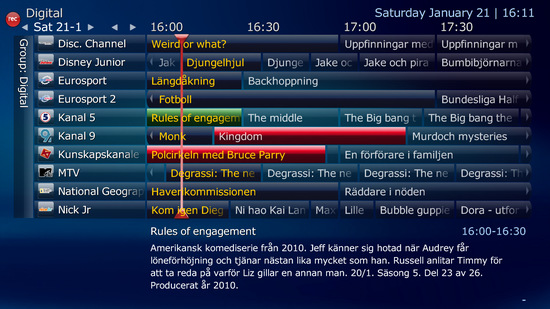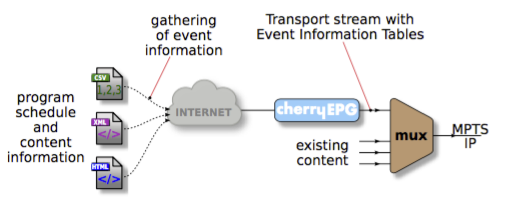Introduction
In the current landscape of television, viewers are presented with an abundance of diverse program content. Gone are the days when channel surfing (zapping) was the sole method of navigating through the multitude of TV channels and services. Today, the dynamics of content search have evolved. Viewers now prefer a curated approach, selecting from organized lists categorized by content types such as film, sports, education, and more.
In response to this shift, viewers demand a structured list with customizable content filters. They seek the ability to set reminders for upcoming preferred content and even schedule event-triggered local recordings. This allows them the flexibility to enjoy their chosen content at a more convenient time. As we embrace this new era of television consumption, our approach to content discovery and access has transformed to align with the evolving preferences of today’s viewers.

Example of an Electronic Program Guide
The Electronic Program Guide (EPG) was conceived precisely to meet these evolving viewer needs. Functioning both as a data service alongside audio and video components, it adds significant value for television service providers. Simultaneously, it serves as an indispensable functional block that a TV set or set-top-box must offer to the viewer.
In essence, the EPG provides on-screen information about the current and upcoming broadcasted content, extending its utility to scheduled program details up to 63 days in advance—although, in practice, this extensive timeline is rarely implemented. Real-world considerations, such as limited receiver memory and channel capacity, dictate a more pragmatic approach. Most network operators provide EPG data for no more than a week ahead, striking a balance between practicality and usefulness.
The constraints arise from the digital receiver’s finite memory, challenged by the storage demands of extensive content-based metadata, leading to potential operational issues. Additionally, distribution systems face limitations in channel capacity, restricting the transmission of large volumes of content-based metadata. Thus, a compromise becomes a judicious and effective solution, ensuring a seamless and reliable Electronic Program Guide experience for viewers in the dynamic landscape of modern television.
cherryEPG is a flexible tool suite, which generates an appropriate digital output data stream from ingested input data for enabling the digital receiver to show an on screen EPG over the rendered video content. Thanks to its configurability, the operator can set his settings within a simple spreadsheet file and reconfigure the system. cherryEPG will extract properties from the *.xls file reconfigure itself accordingly. Such a way of configuration is nowadays not very common, but it allows user friendly configuration planning and documenting at the same time.

Figure 2: EIT generator positioning
The digital receiver renders EPG from a DVB Event Information Table (EIT), specified by ETSI EN 300468 standard and streamed with a multiplexer on the output of TV head-end. Therefore, cherryEPG is connected to the input of the multiplexer. The network operator has to assure, that cherryEPG has access to the external world trough an IT infrastructure.
After scheme configuration it starts to fetch data from different content providers or content aggregators. Many different formats and methods are supported. All the collected event information are stored in the internal database from where the output EIT tables are generated and played out according to the DVB standard EN 300468 and Technical Specification TS 101211. Because the output of the cherryEPG is on IP, it can be physically located anywhere in the network and is not limited to the head-end room. Because the output is standardized, the generated output EITs are suitable for any DVB broadcaster or network operator for use in their cable, satellite or terrestrial distribution network.
cherryEPG supports many networks with hundreds of services and full mashed configuration. With such a flexible configuration options it allows also white label EIT service generation for many distant distribution networks interconnected to the same central distribution point.